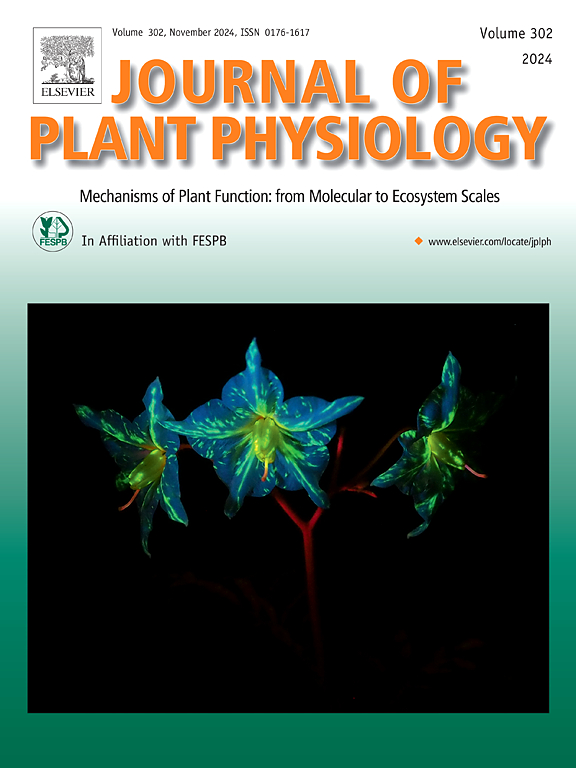HmGST9, an anthocyanin-related glutathione S-transferase gene, is essential for sepals coloration in Hydrangea macrophylla
IF 4.1
3区 生物学
Q1 PLANT SCIENCES
引用次数: 0
Abstract
Flower color is an important ornamental trait of Hydrangea macrophylla. The transport of anthocyanin from endoplasmic reticulum to vacuole for storage is the basis of flower color formation. Glutathione S-transferase (GST) plays an important role in this transport process. However, little is known about the GST genes involved in anthocyanin transport and their functions in H. macrophylla. In this study, the sepals of H. macrophylla ‘Blue Mom’ was used as the experimental material. The gene HmGST9 that may be involved in anthocyanin accumulation was identified from the genome, and it was found to be located in the endoplasmic reticulum and tonoplast. Through Arabidopsis tt19 mutant molecular complementation experiment, it was proved that HmGST9 could restore anthocyanin accumulation in vegetative tissues of Arabidopsis tt19 mutant, but could not restore the color of seed coat. In the sepals of H. macrophylla, virus-induced HmGST9 gene silencing resulted in a significant decrease in anthocyanin content, and the structural genes and transcription factors in the anthocyanin biosynthesis pathway were also significantly down-regulated. In contrast, transient overexpression of HmGST9 in sepals resulted in a significant increase in anthocyanin content and promoted the up-regulation of related structural genes and transport genes. These results indicate that HmGST9 plays an important role in regulating the transport and accumulation of anthocyanins in H. macrophylla, and is of great significance for analyzing the molecular mechanism of flower color formation in H. macrophylla.
HmGST9是花青素相关谷胱甘肽s -转移酶基因,在绣球萼片着色中起重要作用
花色是绣球的重要观赏性状。花青素从内质网转运到液泡储存是花色形成的基础。谷胱甘肽s -转移酶(GST)在这一转运过程中起着重要作用。然而,对于大叶水杨中参与花青素转运的GST基因及其功能知之甚少。本研究以大叶蓼‘蓝妈’的萼片为实验材料。从基因组中鉴定出可能参与花青素积累的基因HmGST9,发现其位于内质网和细胞质中。通过拟南芥tt19突变体分子互补实验,证明HmGST9能恢复拟南芥tt19突变体营养组织花青素积累,但不能恢复种皮颜色。病毒诱导的HmGST9基因沉默导致大叶红萼片花青素含量显著降低,花青素生物合成途径的结构基因和转录因子也显著下调。相比之下,在萼片中瞬间过表达HmGST9导致花青素含量显著增加,并促进相关结构基因和运输基因的上调。这些结果表明,HmGST9在调节大叶红花青素的转运和积累中起着重要作用,对分析大叶红花色形成的分子机制具有重要意义。
本文章由计算机程序翻译,如有差异,请以英文原文为准。
求助全文
约1分钟内获得全文
求助全文
来源期刊

Journal of plant physiology
生物-植物科学
CiteScore
7.20
自引率
4.70%
发文量
196
审稿时长
32 days
期刊介绍:
The Journal of Plant Physiology is a broad-spectrum journal that welcomes high-quality submissions in all major areas of plant physiology, including plant biochemistry, functional biotechnology, computational and synthetic plant biology, growth and development, photosynthesis and respiration, transport and translocation, plant-microbe interactions, biotic and abiotic stress. Studies are welcome at all levels of integration ranging from molecules and cells to organisms and their environments and are expected to use state-of-the-art methodologies. Pure gene expression studies are not within the focus of our journal. To be considered for publication, papers must significantly contribute to the mechanistic understanding of physiological processes, and not be merely descriptive, or confirmatory of previous results. We encourage the submission of papers that explore the physiology of non-model as well as accepted model species and those that bridge basic and applied research. For instance, studies on agricultural plants that show new physiological mechanisms to improve agricultural efficiency are welcome. Studies performed under uncontrolled situations (e.g. field conditions) not providing mechanistic insight will not be considered for publication.
The Journal of Plant Physiology publishes several types of articles: Original Research Articles, Reviews, Perspectives Articles, and Short Communications. Reviews and Perspectives will be solicited by the Editors; unsolicited reviews are also welcome but only from authors with a strong track record in the field of the review. Original research papers comprise the majority of published contributions.
 求助内容:
求助内容: 应助结果提醒方式:
应助结果提醒方式:


